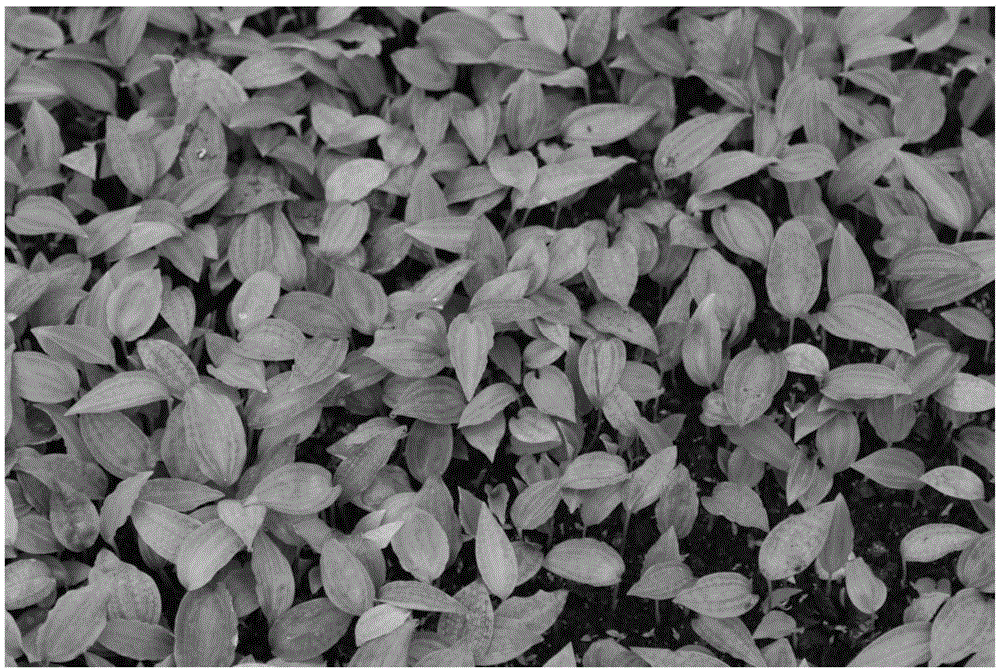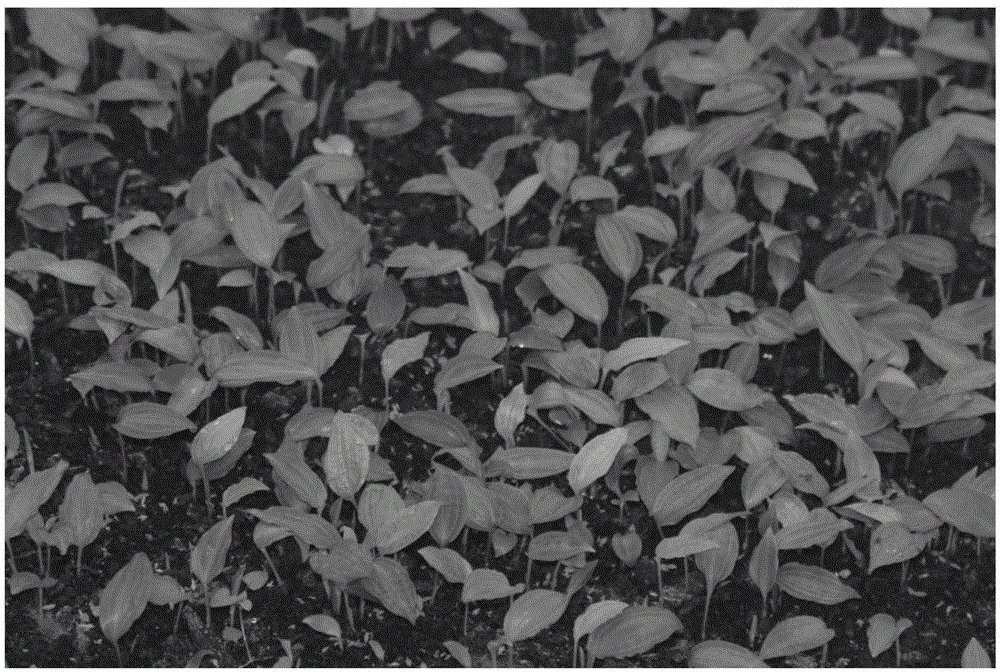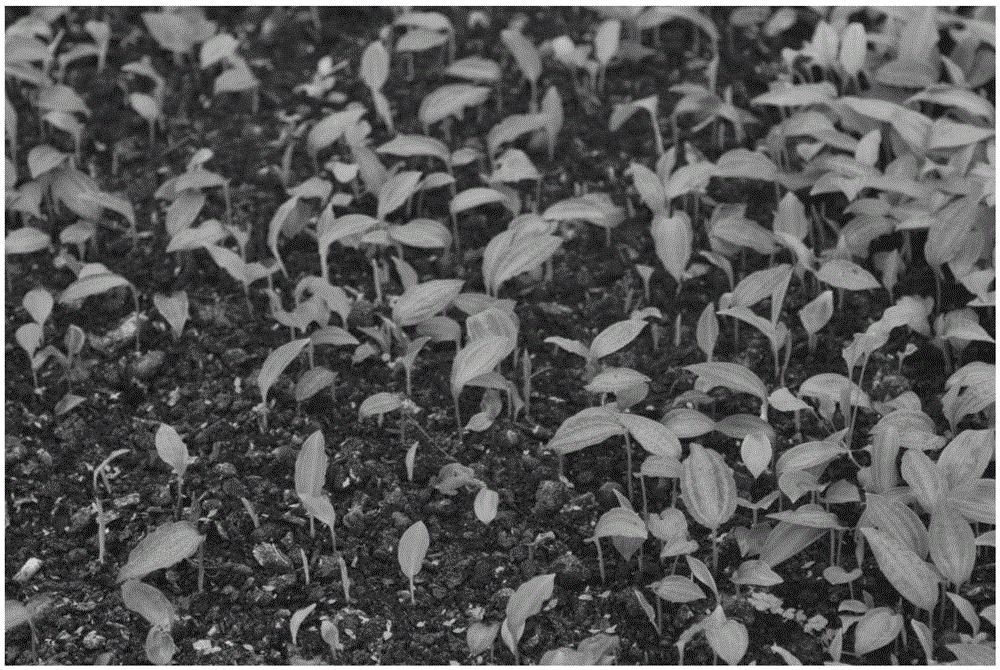Method for seedling sealwort seeds
A technology for seeds and Polygonatum chinensis is applied in the field of seedling breeding of endangered medicinal and edible plants Polygonatum chinensis.
- Summary
- Abstract
- Description
- Claims
- Application Information
AI Technical Summary
Problems solved by technology
Method used
Image
Examples
Embodiment 1
[0028] 1. Treatment of Polygonatum Seeds
[0029] From September to November, harvest mature Polygonatum seeds, rub off the peel, wash them with clean water, soak the seeds in 30-40°C strong tea water for 24 hours, take them out and dry them. Add 10g of green tea to brew.
[0030] 2. Treatment of fine sand for seed dressing
[0031] Mix 5mg / L ABT rooting powder aqueous solution, 15mg / L 6-benzylaminoadenine aqueous solution, and 200mg / L carbendazim aqueous solution in equal volumes, and use the resulting mixture to wet the fine sand, and control the humidity at 30% ~50%.
[0032] 3. Sand storage treatment of Polygonatum seeds
[0033] Evenly mix the Polygonatum seeds treated in Step 1 into the wet fine sand mixed in Step 2, mix 4 to 8 Polygonatum seeds into the wet fine sand per cubic centimeter, then put them into sacks, place them in a cool storehouse, and regularly Water, keep the humidity at 30% to 50%, and hide in sand for 3 months.
[0034] 4. The sowing management o...
Embodiment 2
[0042] 1. Treatment of Polygonatum Seeds
[0043] From September to November, harvest mature Polygonatum seeds, rub off the peel, wash them with clean water, soak the seeds in 30-40°C strong tea water for 24 hours, take them out and dry them. Add 8g of green tea to make it.
[0044] 2. Treatment of fine sand for seed dressing
[0045] Mix 10mg / L ABT rooting powder aqueous solution, 20mg / L 6-benzylaminoadenine aqueous solution, and 150mg / L carbendazim aqueous solution in equal volumes, use the resulting mixture to wet the fine sand, and control the humidity at 30% ~50%.
[0046] 3. Sand storage treatment of Polygonatum seeds
[0047] Evenly mix the Polygonatum seeds treated in Step 1 into the wet fine sand mixed in Step 2, mix 4 to 8 Polygonatum seeds into the wet fine sand per cubic centimeter, then put them into sacks, place them in a cool storehouse, and regularly Water, keep the humidity at 30% to 50%, and hide in sand for 3 months.
[0048] 4. The sowing management of...
Embodiment 3
[0056] 1. Treatment of Polygonatum Seeds
[0057] From September to November, harvest mature Polygonatum seeds, rub off the peel, wash them with clean water, soak the seeds in 30-40°C strong tea water for 24 hours, take them out and dry them. Add 5g of green tea to brew.
[0058] 2. Treatment of fine sand for seed dressing
[0059] Mix 10mg / L aqueous solution of ABT rooting powder, 10mg / L aqueous solution of 6-benzylaminoadenine, and 100mg / L aqueous solution of carbendazim in equal volumes, use the resulting mixture to wet the fine sand, and control the humidity at 30% ~50%.
[0060] 3. Sand storage treatment of Polygonatum seeds
[0061] Evenly mix the Polygonatum seeds treated in Step 1 into the wet fine sand mixed in Step 2, mix 4 to 8 Polygonatum seeds into the wet fine sand per cubic centimeter, then put them into sacks, place them in a cool storehouse, and regularly Water, keep the humidity at 30% to 50%, and hide in sand for 3 months.
[0062] 4. The sowing managem...
PUM
 Login to View More
Login to View More Abstract
Description
Claims
Application Information
 Login to View More
Login to View More - R&D
- Intellectual Property
- Life Sciences
- Materials
- Tech Scout
- Unparalleled Data Quality
- Higher Quality Content
- 60% Fewer Hallucinations
Browse by: Latest US Patents, China's latest patents, Technical Efficacy Thesaurus, Application Domain, Technology Topic, Popular Technical Reports.
© 2025 PatSnap. All rights reserved.Legal|Privacy policy|Modern Slavery Act Transparency Statement|Sitemap|About US| Contact US: help@patsnap.com



